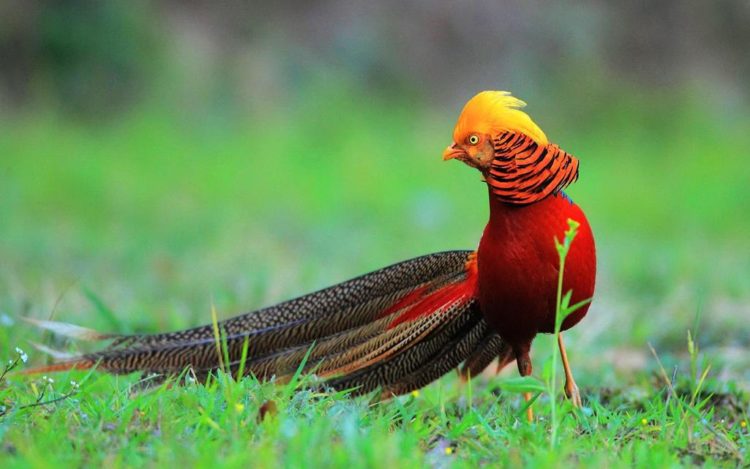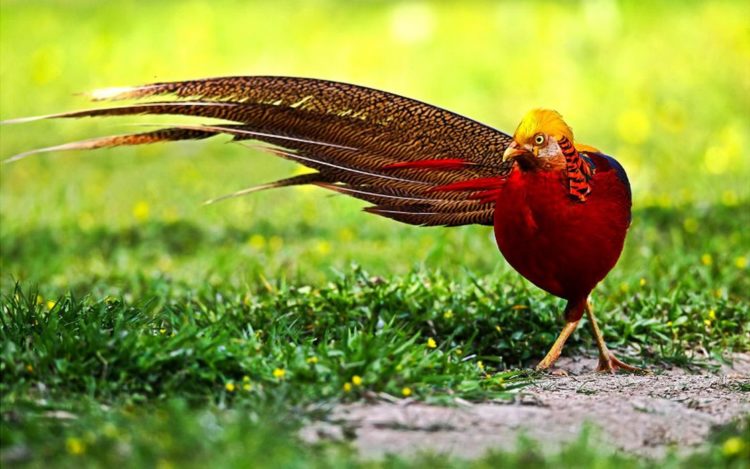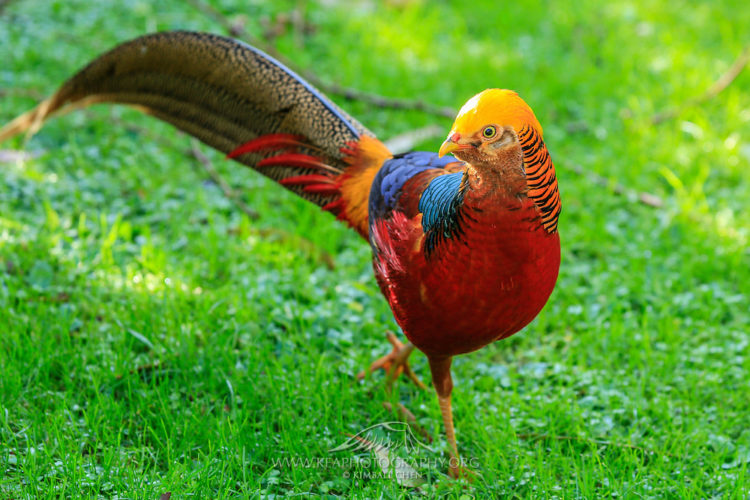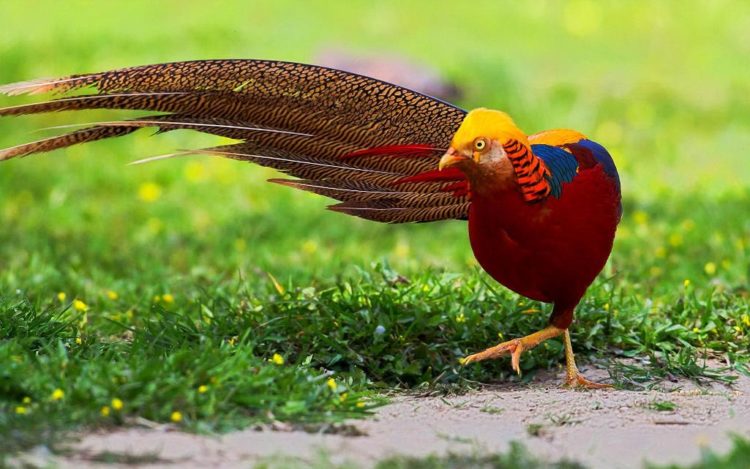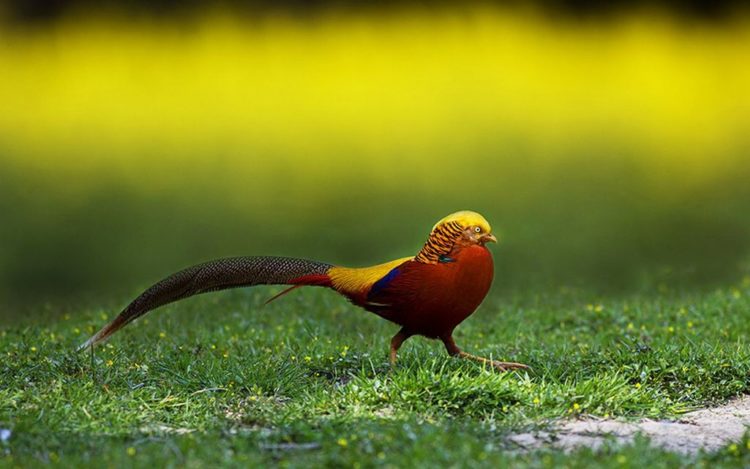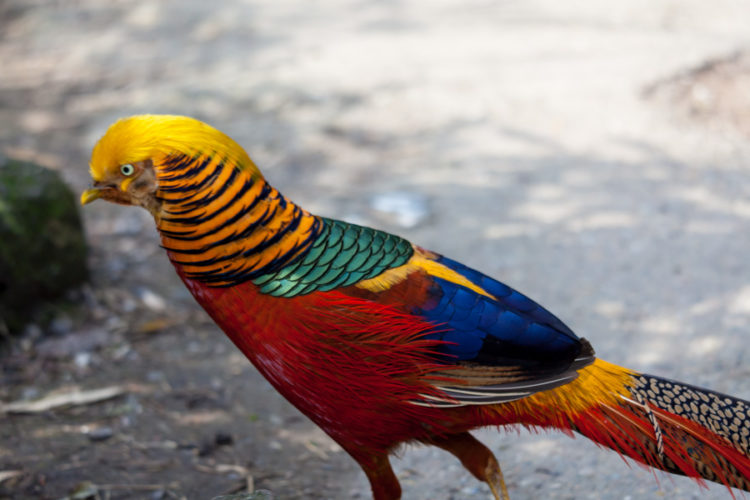The stunning golden pheasant is a gamebird of the order Galliformes (gallinaceous birds) and belongs to the family Phasianidae (pheasants). The Golden Pheasant, or Chinese pheasant, “Chrysolophus pictus,” is native to forests in mountainous areas of western China. Its feral populations have been established in the UK, Canada, the United States, Mexico, Peru, Colombia, Bolivia, Chile, Argentina, Uruguay, Germany, Belgium, the Netherlands, France, Ireland, Australia, and New Zealand. In natural habitats, golden pheasants are particularly aggressive because they have a “harem” structure, mating with several hens a year.
The adult golden pheasant is approximately 90 to 105 cm in length. The golden pheasant is unmistakable with its golden crest, rump, and bright red body. The deep orange “cape” can be a feast in the display, appearing as an alternating black and orange fan that covers all of the faces but its bright yellow eye with a pinpoint black pupil.
The golden pheasants normally lay 8 to 12 eggs at a time and will take 22 to 23 days to incubate. After the pheasant chicks hatch, they are able to run and eat as soon as they are dry. Moreover, golden pheasant eggs are similar in size to a duck egg, making them slightly larger than a chicken’s. The egg taste is light and less rich, like a quail egg. Golden pheasants are omnivorous birds, and therefore pheasants eat both plant and animal matter.
The Malaysian golden pheasant has a golden-yellow crest with a hint of red at the tip. The face, throat, chin, and sides of the neck are rusty tan. The wattles and orbital skin are both yellow in color, and the ruff or cape is light orange. However, the upper back is green, and the rest of the back and rump are golden-yellow.
The main tertiaries are blue, while the scapulars are dark red. Moreover, other characteristics of the male pheasant plumage are the central tail feathers, which are black and spotted with cinnamon, as well as the tip of the tail being a cinnamon buff. The upper tail coverts are the same color as the central tail feathers. The male also has a scarlet breast and scarlet and light chestnut flanks and underparts. The lower legs and feet are a dull yellow
The female golden pheasant is much less showy, with a duller-mottled brown plumage like that of the female common pheasant. She is darker and more slender than the hens of that species, with a tail that is 24 to 31 inches in length. Her breast and sides are barred buff and blackish brown, and the abdomen is plain buff. She has a buff face and throat. Moreover, a few abnormal females may later in their lifetime get some male plumage.
Also, the lower legs and feet are a dull yellow. Hence, both males and females have yellow legs and yellow bills. Keeping golden pheasants can make wonderful pets. Many people are used to seeing wild pheasants with their beautiful plumage; they are a great addition to any aviary and can live with other birds such as chickens and ducks.
Regardless of the male’s showy appearance, these hardy birds are very tough to see in their natural habitat, which is dense, dark young conifer forests with sparse undergrowth. Therefore, little is known about their behavior in the wild. The golden pheasant feed consists of ground grain, leaves, and invertebrates, but they roost in trees at night. They tend to eat berries, grubs, seeds, and other types of vegetation.
The golden pheasant is able to fly fast for short distances; they prefer to run. If startled, however, they will burst into the sky in a “flush.” They fly clumsily in short bursts and spend most of their time on the ground. If startled, they can suddenly burst upwards at great speed and with a distinctive wing sound.
The male golden pheasant has a metallic call in the breeding season. The golden pheasant is usually found in zoos and aviaries, but often as hybrid specimens that are similar to Lady Amherst’s pheasant in their lineage. There are also different mutations of the golden pheasant well-known from birds in captivity, including the dark-throated, yellow, cinnamon, salmon, peach, splash, mahogany, and silver.
Moreover, in aviculture, the wild type is referred to as “red-golden” to differentiate it from these mutations. The wild pheasant is very lean and, if not cooked with care, will taste very dry, very bland, and like chicken, so the pheasant has a mild taste. The meat is white, like chicken, but has a more complex and subtle flavor.
Golden Pheasant too roosts in the trees of the wood, and it is inquisitive that they always tell you where they go to bed. They call it “crok crok” as they settle down to sleep, but partridges sleep on the ground in the fields. The golden pheasant has pinkish-white meat that is full-flavored and low in fat and cholesterol.
Unfortunately, the life span of a golden pheasant is too short; 35% of young birds die before they reach the age of 6 to 10 weeks. Hence, only 2–3% of birds manage to survive to the age of 3 years. So, golden pheasants can survive for up to 3 years in the wild. Nutrition in Pheasant Meat-cooked: it will deliver a very healthy amount of protein as well as significant levels of B vitamins and potassium.
Also, See:
- The Masked Crimson Tanager
- The Banded Broadbill
- The Mystery Bird Yellow Billed Oxpecker
- American Purple Gallinule
- Yellow Cardinal: The One in Million Bird
- The Rufous Treepie

The stunning golden pheasant is a gamebird of the order Galliformes (gallinaceous birds) and belongs to the family Phasianidae (pheasants).



